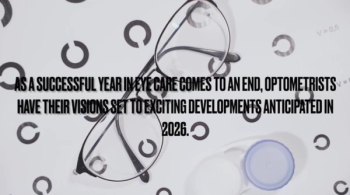
- August digital edition 2023
- Volume 15
- Issue 08
Is it AMD or vitelliform?
Clinicians may have difficulty in making a diagnosis.
Various macular dystrophies can resemble AMD due to the variety of clinical signs and symptoms. Clinicians may find it challenging to differentiate between the retinal conditions. Examples that are commonly confused with AMD include adult-onset foveomacular vitelliform dystrophy (AOFVD), polypoidal choroidal vasculopathy, butterfly-shaped pattern dystrophy, and cone dystrophy.
AMD is frequently misdiagnosed as AOFVD. Although there are distinguishing features, it is challenging to tell them apart due to similarities in the early stages. We will concentrate primarily on the distinctions and similarities between AOFVD and AMD.
Age of onset
Although there is some overlap, the age of onset for AOFVD skews younger than that for AMD. AMD is typically identified in persons older than 50 years; AOFVD is typically found in adults aged 40 to 60 years.1,2
Genetics
Vitelliform dystrophy is a genetic condition that is inherited in an autosomal dominant pattern. This means a parent with the disease has a 50% probability of passing it to each of their offspring. Mutations in the BEST1, PRPH2, IMPG1, and IMPG2 genes have been found to be associated with AOFVD. It is understood that AOFVD has a significant hereditary tendency. On the other hand, it is believed that AMD is brought on by a confluence of genetic and environmental risk factors rather than a straightforward inheritance pattern.
Macular degeneration has been linked to the association of around 30 different genes thus far. The complement cascade, which is located on chromosome 1, and the ARMS2/HTRA genes, which are located on chromosome 10, have been most often connected with AMD. Tobacco use and a general state of poor vascular health, such as hypertension, are among many environmental variables linked to the development of AMD.2–4
Clinical presentation
Both diseases produce deposits as a result of malfunctions at the level of the RPE and the choroid. AMD and AOFVD manifest in the macula as a yellowish lesion. In the early stages, vitelliform deposits may have a clinical appearance like that of drusen in AMD. The most important distinction lies in recognizing the lesion’s size and shape.
Vitelliform lesions have a propensity to be isolated, whereas drusen are observable in clusters. Vitelliform lesions also tend to be more spherical and yellow compared with classic drusen. The physical appearance of both diseases begins to shift as they progress. The progression of AMD often occurs in the following order: fewer drusen, then greater quantity and size of drusen, and finally geographic atrophy, or choroidal neovascular membranes (CNVM).
AOFVD progresses through 4 stages: the vitelliform stage, the pseudohypopyon stage, the vitelliruptive stage, and the atrophic stage.5 The first stage is typically where most of the confusion occurs, particularly when the vitelliform lesion is on the more modest end of the spectrum. Figure 1 shows the different stages of AOFVD, and it is easy to see how the beginning stages of the disease compare to AMD.
Due to the strong genetic predisposition of AOFVD, there is often greater symmetry between the 2 eyes in patients compared with AMD. AMD usually occurs in both eyes but mostly in an asymmetric fashion.
Imaging
Fluorescein angiography is frequently used to distinguish dry AMD from wet AMD, but it is less helpful when it comes to vitelliform dystrophy. The dye enters the lesion, and it is difficult to assess whether the leakage could be from a potential CNVM or from the lesion itself. OCT angiography is more helpful in this case because the technology allows the vascular network to be observed below the vitelliform lesion if CNVM is present. This allows easy differentiation between vitelliform dystrophy and exudative AMD. Another helpful imaging tool is fundus autofluorescence. The vitelliform lesion is easily observable due to its hyperreflective glow (Figure 2).
Progression
Vitelliform dystrophy normally develops over time, whereas AMD can do so more rapidly, particularly in its advanced stage. A patient with AOFVD is shown in Figure 3; the first and second images are separated by approximately 2 years. This patient’s visual acuity has not changed even though the size of the lesion has mildly increased. The progression of AMD is unpredictable; some patients may see minimal change in the number of drusen, whereas others may be headed toward geographic atrophy or exudative AMD. Patients could experience a major decline in vision and contrast sensitivity in addition to an increase in metamorphopsia over the course of a few years.
Treatment
The gold standard for management of mild and moderate stages of AMD involves AREDS 2 (Age-Related Eye Disease Study 2) supplements, discussion about a healthy diet, cessation of smoking, and the importance of UV protection. As the disease progresses, if patients develop geographic atrophy, pegcetacoplan is a recently FDA-approved injection for treatment. For the patients who go on to develop exudative AMD, there are a handful of anti-VEGF injections for treatment. Anti-VEGF treatments are largely successful, with many more undergoing clinical studies.
As for AOFVD, treatment is only available in the presence of CNVM. Close monitoring with imaging is the only option available for physicians. It is not common for patients with vitelliform dystrophy to develop CNVM, but once CNVM is observable, the treatment options are like those for wet AMD. Studies have demonstrated the successful use of ranibizumab (Lucentis) and bevacizumab (Avastin) for patients with CNVM due to AOFVD.6,7
What is the cost of misdiagnosing?
There is power in providing patients with the correct diagnosis. If a patient is given a diagnosis of AMD, there are certain visual and lifestyle expectations to prepare for. It is essential to have conversations about the possibility of the patient experiencing significant vision loss as well as the financial expense of the injections and AREDS 2 supplements that the patient may require for the rest of their lives.
In contrast, vitelliform eye disease causes eyesight to deteriorate gradually, which enables most patients to maintain a significant amount of visual function. Because it is so uncommon for patients to require anti-VEGF injections and there are no other therapeutics available, patients with AOFVD typically do not have to shoulder a significant financial burden associated with treatment. Overall, having an accurate diagnosis allows the patient to have access to necessary resources and better prepare themselves and family members for the changes that may occur due to the disease.
References
1. Bakri SJ, Berrocal A, Capone A Jr, et al. Retina health series: acquired vitelliform lesions. American Society of Retina Specialists. Accessed May 15, 2023. www.asrs.org/patients/retinal-diseases/39/acquired-vitelliform-lesions
2. Age-related macular degeneration (AMD). Johns Hopkins Medicine. Accessed May 15, 2023. www.hopkinsmedicine.org/health/conditions-and-diseases/agerelated-macular-degeneration-amd
3. Adult-onset vitelliform macular dystrophy: about the disease. Genetic and Rare Diseases Information Center. Updated February 2023. Accessed May 15, 2023. rarediseases.info.nih.gov/diseases/10909/adult-onset-vitelliform-macular-dystrophy
4. Seddon JM. Macular degeneration epidemiology: nature-nurture, lifestyle factors, genetic risk, and gene-environment interactions – the Weisenfeld Award Lecture. Invest Opthalmol Vis Sci. 2017;58(14):6513-6528. doi:10.1167/iovs.17-23544
5. Querques G, Forte R, Querques L, Massamba N, Souied EH. Natural course of adult-onset foveomacular vitelliform dystrophy: a spectral-domain optical coherence tomography analysis. Am J Ophthalmol. 2011;152(2):304-313. doi:10.1016/j.ajo.2011.01.047
6. Montero JA, Ruiz-Moreno JM, De La Vega C. Intravitreal bevacizumab for adult-onset vitelliform dystrophy: a case report. Eur J Ophthalmol. 2007;17(6):983-986. doi:10.1177/112067210701700620
7. Gallego-Pinazo R, Dolz-Marco R, Pardo-Lopez D, Arevalo JF, Diaz-Llopis M. Primary intravitreal ranibizumab for adult-onset foveomacular vitelliform dystrophy. Graefes Arch Clin Exp Ophthalmol. 2011;249(3):455-458. doi:10.1007/s00417-010-1536-1
Articles in this issue
over 2 years ago
Geographic atrophy is a major concern in eye healthover 2 years ago
Managing cooperatively with patientsover 2 years ago
OCT is a crucial tool in glaucoma diagnosis and monitoringover 2 years ago
Historic signing at AOA: All about the 13% PromiseNewsletter
Want more insights like this? Subscribe to Optometry Times and get clinical pearls and practice tips delivered straight to your inbox.









































